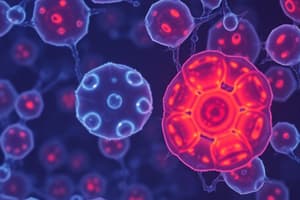Podcast
Questions and Answers
What is the main focus of chapter one?
What is the main focus of chapter one?
- Model organisms in cell and molecular biology
- Cell diversity in the environment (correct)
- Comparison of prokaryotic and eukaryotic cells
- Cell structure and function
What does the speaker mention about prokaryotic versus eukaryotic cells?
What does the speaker mention about prokaryotic versus eukaryotic cells?
- They have similar structures but different functions
- They have different structures and functions (correct)
- They are not discussed in detail in the chapter
- They are only found in plants and animals respectively
What variation can be observed in single cell organisms?
What variation can be observed in single cell organisms?
- They are all simple organisms with no variations
- Their appearance and function can vary based on their environment and function (correct)
- Their complexity is always dependent on their size
- They all have similar flagella structures
What will be reviewed in detail as the semester progresses?
What will be reviewed in detail as the semester progresses?
What is the purpose of discussing model organisms?
What is the purpose of discussing model organisms?
What is the main focus of the chapter discussed in the text?
What is the main focus of the chapter discussed in the text?
Which type of cells will be reviewed in detail as the semester progresses?
Which type of cells will be reviewed in detail as the semester progresses?
What is a characteristic feature of some single-cell organisms mentioned in the text?
What is a characteristic feature of some single-cell organisms mentioned in the text?
What is emphasized as a factor contributing to the complexity of single-cell organisms?
What is emphasized as a factor contributing to the complexity of single-cell organisms?
What is the purpose of discussing different types of microscopies in the chapter?
What is the purpose of discussing different types of microscopies in the chapter?
Flashcards
Prokaryotic cells
Prokaryotic cells
Single-celled organisms like bacteria, archaea, and some protists.
Eukaryotic cells
Eukaryotic cells
Cells with a nucleus and membrane-bound organelles. Found in plants, animals, fungi, and protists.
Cell Biology
Cell Biology
The study of the structure and function of cells. It explores how cells work and interact.
Model Organisms
Model Organisms
Signup and view all the flashcards
Pseudopods
Pseudopods
Signup and view all the flashcards
Microscopy Techniques
Microscopy Techniques
Signup and view all the flashcards
Resolution
Resolution
Signup and view all the flashcards
Optics
Optics
Signup and view all the flashcards
Light Microscopy
Light Microscopy
Signup and view all the flashcards
Electron Microscopy
Electron Microscopy
Signup and view all the flashcards
Study Notes
Chapter One Overview
- The main focus of chapter one is the exploration of single-cell organisms, including prokaryotic and eukaryotic cells.
Prokaryotic vs Eukaryotic Cells
- The speaker highlights the differences between prokaryotic and eukaryotic cells, with the former lacking a true nucleus and the latter having a true nucleus.
Variation in Single-Cell Organisms
- Variation in single-cell organisms can be observed in terms of their structure, function, and size.
Review of Cells and Model Organisms
- The semester will review eukaryotic cells in detail, focusing on their complexity and diversity.
- The purpose of discussing model organisms is to understand the biology of complex organisms by studying simpler ones.
Complexity of Single-Cell Organisms
- One characteristic feature of some single-cell organisms is their ability to survive in extreme environments.
- The complexity of single-cell organisms is contributed to by factors such as their internal structure and adaptations.
Microscopy
- The purpose of discussing different types of microscopies in the chapter is to understand how they are used to study single-cell organisms and their structures.
Studying That Suits You
Use AI to generate personalized quizzes and flashcards to suit your learning preferences.




